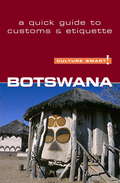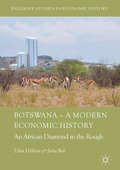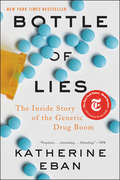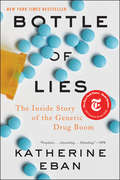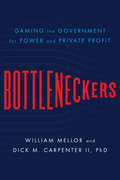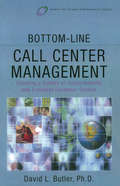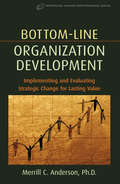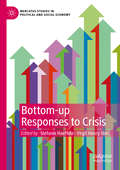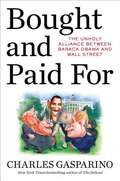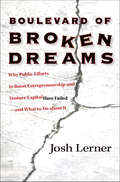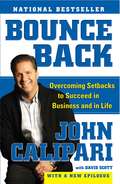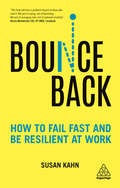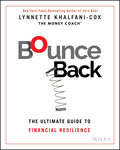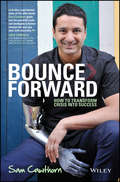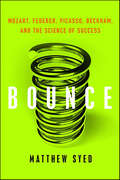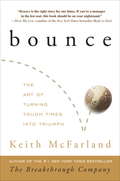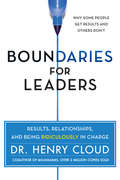- Table View
- List View
Boston Whaler, Inc.: Managing the Dealer Network
by Thomas V. Bonoma Margaret L. KaneMr. Joseph Lawler, newly-appointed president of Boston Whaler, Inc. (BWI), believes that better dealer management is the key to his company's continued growth. BWI manufactured a high-price, high performance line of power and other boats for the recreational, commercial, and other markets. Its 250 dealers were served by a small force of regional managers. Most dealers were not exclusively Whaler distributors, and Whaler sales ordinarily did not account for the majority of dealer revenues. Mr. Lawler wants the dealers' "commitment" to BWI increased, whether through new dealer agreements, training, minimum stocking requirements or whatever other device will help increase the importance of the BWI relationship to the dealers. Presents a relatively complete account of distribution management problems, and additionally, allows a thorough key account analysis of BWI's top 50 dealers.
Botswana - Culture Smart!
by Michael MainCulture Smart! provides essential information on attitudes, beliefs and behavior in different countries, ensuring that you arrive at your destination aware of basic manners, common courtesies, and sensitive issues. These concise guides tell you what to expect, how to behave, and how to establish a rapport with your hosts. This inside knowledge will enable you to steer clear of embarrassing gaffes and mistakes, feel confident in unfamiliar situations, and develop trust, friendships, and successful business relationships.Culture Smart! offers illuminating insights into the culture and society of a particular country. It will help you to turn your visit-whether on business or for pleasure-into a memorable and enriching experience. Contents include* customs, values, and traditions* historical, religious, and political background* life at home* leisure, social, and cultural life* eating and drinking* dos, don'ts, and taboos* business practices* communication, spoken and unspoken"Culture Smart has come to the rescue of hapless travellers." Sunday Times Travel"... the perfect introduction to the weird, wonderful and downright odd quirks and customs of various countries." Global Travel"...full of fascinating-as well as common-sense-tips to help you avoid embarrassing faux pas." Observer"...as useful as they are entertaining." Easyjet Magazine"...offer glimpses into the psyche of a faraway world." New York Times
Botswana – A Modern Economic History: An African Diamond In The Rough (Palgrave Studies In Economic History)
by Ellen Hillbom Jutta BoltTogether with Mauritius, Botswana is often categorized as one of two growth miracles in sub-Saharan Africa. Due to its spectacular long-run economic performance and impressive social development, it has been termed both an economic success story and a developmental state. While there is uniqueness in the Botswana experience, several aspects of the country’s opportunities and challenges are of a more general nature. Throughout its history, Botswana has been both blessed and hindered by its natural resource abundance and dependency, which have influenced growth periods, opportunities for economic diversification, strategies for sustainable economic and social development, and the distribution of incomes and opportunities.Through a political economy framework, Hillbom and Bolt provide an updated understanding of an African success story, covering the period from the mid-19th century, when the Tswana groups settled, to the present day. Understanding the interaction over time between geography and factor endowments on the one hand, and the development of economic and political institutions on the other, offers principle lessons from Botswana’s experience to other natural resource rich developing countries.
Botswana: 2003 Article IV Consultation--Staff Report; Staff Supplement; Public Information Notice on the Executive Board Discussion; and Statement by the Executive Director for Botswana
by International Monetary FundA report from the International Monetary Fund.
Botswana: 2007 Article IV Consultation--Staff Report; Public Information Notice on the Executive Board Discussion; and Statement by the Executive Director for Botswana
by International Monetary FundA report from the International Monetary Fund.
Botswana: A Diamond in the Rough
by Laura Alfaro Debora L. Spar Vinati Dev Faheen AllibhoyIn the years since independence, tiny, landlocked Botswana has gone from being one of the world's poorest nations to becoming a stable, prosperous state, blessed with the highest sustained growth rate in the world. This case highlights the role that foreign direct investment (FDI) has played in this success, as well as how strong local institutions have helped to harness the benefits that the foreign investor--here, the giant De Beers company--has brought. Also, examines how Botswana was able to avoid the natural resource curse that has haunted so many other resource-abundant countries.
Botswana: Technical Assistance Report-national Accounts Mission (Imf Staff Country Reports)
by International Monetary Fund. Statistics Dept.A report from the International Monetary Fund.
Bottle of Lies: The Inside Story of the Generic Drug Boom
by Katherine EbanFrom an award-winning journalist, an explosive narrative investigation of the generic drug boom that reveals fraud and life-threatening dangers on a global scale—The Jungle for pharmaceuticalsMany have hailed the widespread use of generic drugs as one of the most important public-health developments of the twenty-first century. Today, almost 90 percent of our pharmaceutical market is comprised of generics, the majority of which are manufactured overseas. We have been reassured by our doctors, our pharmacists and our regulators that generic drugs are identical to their brand-name counterparts, just less expensive. But is this really true?Katherine Eban’s Bottle of Lies exposes the deceit behind generic-drug manufacturing—and the attendant risks for global health. Drawing on exclusive accounts from whistleblowers and regulators, as well as thousands of pages of confidential FDA documents, Eban reveals an industry where fraud is rampant, companies routinely falsify data, and executives circumvent almost every principle of safe manufacturing to minimize cost and maximize profit, confident in their ability to fool inspectors. Meanwhile, patients unwittingly consume medicine with unpredictable and dangerous effects.The story of generic drugs is truly global. It connects middle America to China, India, sub-Saharan Africa and Brazil, and represents the ultimate litmus test of globalization: what are the risks of moving drug manufacturing offshore, and are they worth the savings? A decade-long investigation with international sweep, high-stakes brinkmanship and big money at its core, Bottle of Lies reveals how the world’s greatest public-health innovation has become one of its most astonishing swindles.
Bottle of Lies: The Inside Story of the Generic Drug Boom
by Katherine EbanA NEW YORK TIMES BESTSELLER New York Times 100 Notable Books of 2019New York Public Library Best Books of 2019 Kirkus Reviews Best Health and Science Books of 2019Science Friday Best Books of 2019 New postscript by the authorFrom an award-winning journalist, an explosive narrative investigation of the generic drug boom that reveals fraud and life-threatening dangers on a global scale—The Jungle for pharmaceuticalsMany have hailed the widespread use of generic drugs as one of the most important public-health developments of the twenty-first century. Today, almost 90 percent of our pharmaceutical market is comprised of generics, the majority of which are manufactured overseas. We have been reassured by our doctors, our pharmacists and our regulators that generic drugs are identical to their brand-name counterparts, just less expensive. But is this really true?Katherine Eban’s Bottle of Lies exposes the deceit behind generic-drug manufacturing—and the attendant risks for global health. Drawing on exclusive accounts from whistleblowers and regulators, as well as thousands of pages of confidential FDA documents, Eban reveals an industry where fraud is rampant, companies routinely falsify data, and executives circumvent almost every principle of safe manufacturing to minimize cost and maximize profit, confident in their ability to fool inspectors. Meanwhile, patients unwittingly consume medicine with unpredictable and dangerous effects.The story of generic drugs is truly global. It connects middle America to China, India, sub-Saharan Africa and Brazil, and represents the ultimate litmus test of globalization: what are the risks of moving drug manufacturing offshore, and are they worth the savings? A decade-long investigation with international sweep, high-stakes brinkmanship and big money at its core, Bottle of Lies reveals how the world’s greatest public-health innovation has become one of its most astonishing swindles.
Bottleneckers: Gaming the Government for Power and Private Profit
by Dick M. Carpenter II William MellorBottlenecker (n): a person who advocates for the creation or perpetuation of government regulation, particularly an occupational license, to restrict entry into his or her occupation, thereby accruing an economic advantage without providing a benefit to consumers.The Left, Right, and Center all hate them: powerful special interests that use government power for their own private benefit. In an era when the Left hates "fat cats" and the Right despises "crony capitalists," now there is an artful and memorable one-word pejorative they can both get behind: bottleneckers.A "bottlenecker" is anyone who uses government power to limit competition and thereby reap monopoly profits and other benefits. Bottleneckers work with politicians to constrict competition, entrepreneurial innovation, and opportunity. They thereby limit consumer choice; drive up consumer prices; and they support politicians who willingly overstep the constitutional limits of their powers to create, maintain, and expand these anticompetitive bottlenecks.The Institute for Justice's new book Bottleneckers coins a new word in the American lexicon, and provides a rich history and well-researched examples of bottleneckers in one occupation after another-from alcohol distributors to taxicab cartels-pointing the way to positive reforms.
Bottom-Line Call Center Management
by David L. Butler'Bottom-Line Call Center Management breaks new ground by addressing key skills and techniques in assessing and implementing effective management practices to maximize the human and capital resources at the call center manager's disposal. Drawing on the author's unique data sets and years of research experience in the industry, 'Bottom-Line Call Center Management' helps call center managers evaluate their current status, implement cost-effective changes, and measure results of their changes to ensure a culture of accountability within the call center at all levels increasing the bottom line. The processes include an evaluation of current customer service representatives, defining, delimiting and assessing the labor shed of the center, and exploring the customer service representative's unique skills and leveraging those skills into a unique and dynamic work environment. Likewise, the process also determines the learning skills and competencies necessary to meet and exceed the basic requirements for all call centers. Furthermore, each step has a pre, in-process, and post evaluation to ensure projects are progressing according to plan. Lastly, all evaluations are measured against the bottom line through a return on investment (ROI) model.The framework for this book uses the culture of call centers, defined and lived through the customer service representatives, as the lens to view all processes, measurements, accountability and return on investment. This framework is critical since there has been much emphasis on technology-as-a-solution which treats the employees as a hindrance instead of the enablers of positive change. Likewise, customer service representatives eventually act as strong determinants of success with the call center and thus the bottom line.
Bottom-Line Organization Development
by Merrill AndersonOrganization development practitioners have, for over half a century, engaged with organizations to help them grow and thrive. The artful application of Organization Development (OD) has helped business leaders articulate vision, rethink business processes, create more fluid organization structures and better utilize people's talents. While business leaders and OD practitioners intuitively believe that OD provides valuable results, rigorous measurement of the value delivered has long eluded many OD practitioners.'Bottom-Line Organization Development' provides powerful tools to capture and measure the financial return on investment (ROI) of OD projects to the business. Given the increasing competition for budget and resources within organizations and the requirements of demonstrating tangible results, the need for such OD measurement tools is very high. But in addition to proving the value of OD projects, integrating evaluation into the change management process itself can actually increase the value of the change initiative because it opens up new ways of capturing and increasing the value of change initiatives. In other words, there is an ROI to ROI. Merrill Anderson calls this new way of approaching OD "strategic change valuation." The book explains the five steps in the OD value process - diagnosis, design, deployment, evaluation and reflection. In addition, three case studies take readers through the process of applying bottom-line OD to three types of popular strategic change initiatives: executive coaching, organization capability, and knowledge management. Readers will gain a holistic perspective of how to make the seemingly intangible benefits of these initiatives tangible.
Bottom-up Responses to Crisis (Mercatus Studies in Political and Social Economy)
by Virgil Henry Storr Stefanie HaeffeleCrises occur in all societies across world, and can be natural (such as hurricanes, flooding, and earthquakes), man-made (such as wars and economic downturns), or, often, a combination of both (such as famines, the flooding of New Orleans in 2005 after Hurricane Katrina and subsequent levy failures, and the earthquake, tsunami, and nuclear disaster in Japan in 2011). Crises cause fatalities, injuries, and property damages as well as introduce uncertainty and challenges for individuals, societies, and polities. Yet, we see individuals and communities rebounding effectively from crises all the time. How do communities go about returning to normalcy and beginning again the mundane life of every day affairs? This edited volume looks at bottom-up responses to crises. The chapters in this volume will highlight the ingenuity and persistence of individuals and private organizations as well as discuss the possibilities, limitations, and adaptability of bottom-up responses. It argues that there are many ways that local leaders, entrepreneurs, and community members can play a role in their own recovery by examining the capabilities, feedback mechanisms, and network effects of decentralized crisis response and recovery efforts. Chapters will focus on the role of local emergency managers in the disaster management process and offer suggestions for reform and the role of businesses, citizens, and children in providing crisis response and recovery. This book will also consider theories of self-governance and nonviolent action in encouraging and sustaining bottom-up recovery.
Bought and Paid For
by Charles GasparinoA top reporter exposes the deep ties between the Obama administration and the big banks that are bankrupting our country. As the recession continues, President Obama has chastised the "fat cats" who feast off government bailout money while unemployment remains high and smaller businesses struggle. But according to Gasparino, Obama is faking his outrage, and his calls for new policies to rein in banks that are "too big to fail" are just pabulum. In reality, Obama has climbed into bed with Wall Street CEOs, giving them what they want so they will support his liberal, big- government agenda. As a result, the big banks responsible for the credit crisis get rescued, while small businesses and ordinary Americans get crushed by higher taxes and irresponsible spending. Gasparino draws on interviews with dozens of key CEOs and political players to trace the roots of Wall Street's twisted love affair with one of the most liberal presidents in American history. He shows how, for decades, big banks and big business have colluded with big government, thereby laying the groundwork for today's shady dealings, and how the same bankers Obama now publically reprimands have supported him-not because he promises change, but because he promises business. Written in Gasparino's characteristic smart yet no-nonsense style, this book is both an exposé and a wake-up call to all Americans to strike back against the people and policies who are ruining our country. .
Boulevard of Broken Dreams: Why Public Efforts to Boost Entrepreneurship and Venture Capital Have Failed—and What to Do about It (The Kauffman Foundation Series on Innovation and Entrepreneurship #11)
by Josh LernerHow governments can do a better job of supporting entrepreneurship and venture capitalSilicon Valley, Singapore, Tel Aviv—the global hubs of entrepreneurial activity—all bear the marks of government investment. Yet, for every public intervention that spurs entrepreneurial activity, there are many failed efforts that waste untold billions in taxpayer dollars. When has governmental sponsorship succeeded in boosting growth, and when has it fallen terribly short? Should the government be involved in such undertakings at all? Boulevard of Broken Dreams is the first extensive look at the ways governments have supported entrepreneurs and venture capitalists across decades and continents. Josh Lerner, one of the foremost experts in the field, provides valuable insights into why some public initiatives work while others are hobbled by pitfalls, and he offers suggestions for how public ventures should be implemented in the future.Discussing the complex history of Silicon Valley and other pioneering centers of venture capital, Lerner uncovers the extent of government influence in prompting growth. He examines the public strategies used to advance new ventures, points to the challenges of these endeavors, and reveals the common flaws undermining far too many programs—poor design, a lack of understanding for the entrepreneurial process, and implementation problems. Lerner explains why governments cannot dictate how venture markets evolve, and why they must balance their positions as catalysts with an awareness of their limited ability to stimulate the entrepreneurial sector.As governments worldwide seek to spur economic growth in ever more aggressive ways, Boulevard of Broken Dreams offers an important caution. The book argues for a careful approach to government support of entrepreneurial activities, so that the mistakes of earlier efforts are not repeated.
Bounce Back
by John CalipariIf recent history has taught us anything, it's that nobody goes through life unscathed--no matter how rich, how smart, how talented, or how fortunate they may be. White collar, blue collar, or no collar, there is an undeniable commonality to the raw emotion that strikes people when they are knocked down. University of Kentucky basketball coach John Calipari has experienced his share of public setbacks, but he has learned that bad situations are permanent only if you allow them to be. What Coach Cal--as players, peers, and his legion of fans that make up the Big Blue Nation call him--learned from his experiences was the importance of having the right attitude when dealing with life's major impediments. On the court and off, he emphasizes to his players that a big part of success is being able to handle obstacles. Now he is offering you the chance to learn the same strategies that he teaches the young men who play for him. By becoming an active participant in your own resurrection--through practice exercises and tips from Coach Cal and his deep bench of highly successful people--you too will gain the tools and insight to understand that it's never a matter of how far you have fallen, but instead it's about how high you bounce back.tion of tough love and understanding, Coach Cal takes you under his wing in much the same fashion he guides the young men who play for him. By becoming an active participant in your own resurrection -- through practice exercises and tips from Coach Cal and his deep bench of highly successful people who have survived their own bounce backs -- you too will gain the tools and insight to understand that it's never a matter of how far you have fallen, but instead it's about how high you bounce back.
Bounce Back: How to Fail Fast and be Resilient at Work
by Dr Susan KahnSuccess. Innovation. Creativity. Growth.We all want these things at work - but the one thing they all have in common is that they involve failure. A fear of failure, or the inability to bounce back and learn from failures, is one of the biggest things that can hold us back in our professional development - so how do we learn how to fail well and develop our resilience? Wherever we work, and whatever role we deliver, we all have the power to change our thinking and our response to failure - Bounce Back is here to help. Written by consultant and teacher, Dr Susan Kahn, this book will show you how to embrace failure. Failing fast, failing well, and learning how to be agile and resilient at work is a vital part of being a successful and innovative leader, approaching opportunities with excitement and creativity, and driving forward your personal and professional growth. Packed with practical exercises, inspirational case studies, and a useful resilience self-assessment guide, Bounce Back will show you how to invest in your resilience in a deliberate way, and empower you to face risk head-on. From learning how to respond well to critical feedback, to understanding cultural attitudes to failure around the world, this book will help you be a stronger, more resilient you.
Bounce Back: The Ultimate Guide to Financial Resilience
by Lynnette Khalfani-CoxIn Bounce Back, veteran financial coach and bestselling author Lynnette Khalfani-Cox explains how she slayed six figures of consumer debt in a mere three years and went on to build a seven-figure personal net worth. The author shows you how to take on—and defeat—the most common and difficult challenges facing Americans today, from debt, disability, and job downsizing to disasters, discrimination, divorce, and more. She draws on her own extensive experience helping people with their most intractable financial problems, the wisdom of other money coaches, financial therapists, certified financial planners, and psychologists – as well as the inspiring stories of everyday people who have bounced back from adversity. Emphasizing the critical importance of emotional, financial, social, and physical resilience, Bounce Back demonstrates 10 practical and hands-on techniques you can implement immediately to build your resilience and recover fiscally and emotionally from the most frequently experienced personal finance setbacks. You’ll also discover: How to handle the ever-rising cost of living and the increased impact of high levels of inflation Actionable strategies for burning down your debt as fast as reasonably possible Practical advice for people who face discrimination and maltreatment in the financial, housing, and employment marketsAn essential and endlessly inspiring roadmap to a better financial tomorrow, Bounce Back is an expert guide to transforming a seemingly impossible challenge into a manageable setback you can overcome with skill, faith, and resilience.
Bounce Forward
by Sam CawthornAn inspiring business book that shows leaders and businesspeople how to turn adversity into innovation, productivity, and profitabilityWhen he was just twenty-six years old, Sam Cawthorn's life changed forever. A terrible car accident cost him his arm, left him in a coma, and put him in a wheelchair for the rest of his life--or so he thought. Today, Sam is one of the most successful motivational and inspirational speakers around, addressing some 100,000 people around the world each year, from some of the world's biggest companies. Sam's recovery was more than just a bounce back to where he had been before the accident. Instead, he used his accident as a launching pad to bounce forward to reach even greater heights than before. Now, Sam uses his own story to share the secrets of both personal and corporate turnarounds, how to use adversity as a springboard to greater heights not just for individuals, but also for companies and teams. Sam speaks to bankers, salespeople, leaders, corporate executives, government workers, students, and anyone else who faces challenges and setbacks every day.In Bounce Forward, Sam shares the tools, strategies, and psychology that anyone can use to overcome any obstacle. If Sam can bounce forward from the accident that nearly took his life, there's almost nothing that you can't overcome.An inspiring and motivational guide to overcoming challenges in life and in businessIdeal for corporate leaders and employees, business managers, and anyone else who needs to motivate themselves or their teamsPacked with the tools, strategies, and secret formulas it takes to turn adversity into successNo matter what kind of challenge you face--in the office, at home, or even in your own heart--Bounce Forward gives you the insight you need to climb higher than ever before, in business or in life.
Bounce: Mozart, Federer, Picasso, Beckham, and the Science of Success
by Matthew Syed“Insightful and entertaining . . . Takes us a step deeper into the world of sports, showing us how much we can learn about our own behavior.” —Dan Ariely, New York Times–bestselling authorWhy have all the sprinters who have run the 100 meters in under ten seconds been black?What’s one thing Mozart, Venus Williams, and Michelangelo have in common?Is it good to praise a child’s intelligence?Why are baseball players so superstitious?Few things in life are more satisfying than beating a rival. We love to win and hate to lose, whether it’s on the playing field or at the ballot box, in the office or in the classroom. In this bold new look at human behavior, award-winning journalist and Olympian Matthew Syed explores the truth about our competitive nature—why we win, why we don’t, and how we really play the game of life. Bounce reveals how competition—the most vivid, primal, and dramatic of human pursuits—provides vital insight into many of the most controversial issues of our time, from biology and economics, to psychology and culture, to genetics and race, to sports and politics.Backed by cutting-edge scientific research and case studies, Syed shatters long-held myths about meritocracy, talent, performance, and the mind. He explains why some people thrive under pressure and others choke, and weighs the value of innate ability against that of practice, hard work, and will. From sex to math, from the motivation of children to the culture of big business, Bounce shows how competition provides a master key with which to unlock the mysteries of the world.“Readers who gobbled up Freakonomics and Predictably Irrational will flock to this one.”—Publishers Weekly
Bounce: The Art of Turning Tough Times into Triumph
by Keith McfarlandWhy do many people and companies crumble in the face of difficulty, while others use adversity to bounce back even stronger? Here from New York Times bestselling author Keith McFarland is a leadership fable for those wary of fables, a story that rejects pat, heard-it-before advice and showsuin a startlingly fresh wayuhow to use challenges to make both yourself and your organization stronger. Mike Maloney, division manager for Boston-area tech firm CRX, returns from a business trip late one night feeling demoralized. His unit is about to lose its biggest customer and its most valuable employee. Mike wonders how much longer he and his staff can keep up their relentless work schedule and meet upper management's new request for cost cuts. Something has to give. Hoping to blow off steam, he heads to a gym, where he runs into Joe, a former army Ranger. After listening to Mike vent about the cards he's been dealt, the ex-soldier says, "Sounds like your company is ready to bounce. " Mike looks confused, so Joe begins tutoring him in lessons from the battlefield. It is precisely when all seems lost, says Joe, that the opportunity exists to rethink a situation and make real progress. Over the next two weeks, Joe turns Mike's view of himself and his company upside down. Despite his Ivy League MBA and extensive experience running companies, Mike has a lot to learn from this young grunt just back from Afghanistan. For example, he learns that under pressure, people experience two kinds of anxietyuone that hurts performance and one that helps it. Mike uses the insight to get his troops running toward the sound of gunfire, and in the process, learns that "bounce" can happen outside the workplace, too. With Joe's help, he finds his own personal bounce. Drawing inspiration from such sources as the work of M. I. T. social scientist Ed Schein, the film Saving Private Ryan, and his own experiences as a CEO leading companies, McFarland cleverly weaves a story whose practical insights can be put to use immediately. With an invaluable wrap-up section at the book's end that analyzes each of the key ideas and shows how they can be applied in work and personal life, Bounce may be the most indispensable guide to facing challenges ever written.
Boundaries Need Not Be Barriers: Leading Collaboration Among Groups in Decentralized Organizations
by Max H. Bazerman Heather M. Caruso Todd RogersEmployees in decentralized organizations often note that it is harder to work with other divisions or departments within their own organization than it is to work with outside suppliers or customers. Instances of coordination failure often stem from the failure to structure the organization appropriately according to the key interdependencies in the organization, whether that suggests organization by function, by product group, or by region. But no matter how a multidivisional organization is designed, it needs to find effective ways to spontaneously and responsively coordinate information and activity across its units. This chapter aims to help leaders of decentralized organizations understand and overcome three key barriers to effective coordination and collaborative information sharing across organizational boundaries. This chapter was previously published as chapter 9 of "Crossing the Divide: Intergroup Leadership in a World of Difference."
Boundaries for Leaders: Results, Relationships, and Being Ridiculously in Charge
by Henry CloudIn Boundaries for Leaders, clinical psychologist and bestselling author Dr. Henry Cloud leverages his expertise of human behavior, neuroscience, and business leadership to explain how the best leaders set boundaries within their organizations--with their teams and with themselves--to improve performance and increase employee and customer satisfaction. In a voice that is motivating and inspiring, Dr. Cloud offers practical advice on how to manage teams, coach direct reports, and instill an organization with strong values and culture. Boundaries for Leaders: Take Charge of Your Business, Your Team, and Your Life is essential reading for executives and aspiring leaders who want to create successful companies with satisfied employees and customers, while becoming more resilient leaders themselves.
Boundaries of Clan and Color: Transnational Comparisons of Inter-Group Disparity (Advances In Social Economics Ser. #No.9)
by Jr. Ashwini Deshpande William DarityEconomic disparity between ethnic and racial groups is a ubiquitous and pervasive phenomenon internationally. Gaps between groups encompass employment, wage, occupational status and wealth differentials. Virtually every nation is comprised of a group whose material well-being is sharply depressed in comparison with another, socially dominant group.
Boundaries of Loyalty
by Berman Saul J.Talmudic legislation prescribed penalty for a Jew to testify in a non-Jewish court, against a fellow Jew, to benefit a gentile - for breach of a duty of loyalty to a fellow Jew. Through close textual analysis, Saul Berman explores how Jewish jurists responded when this virtue of loyalty conflicted with values such as Justice, avoidance of desecration of God's Name, deterrence of crime, defence of self, protection of Jewish community, and the duty to adhere to Law of the Land. Essential for scholars and graduate students in Talmud, Jewish law and comparative law, this key volume details the nature of these loyalties as values within the Jewish legal system, and how the resolution of these conflicts was handled. Berman additionally explores why this issue has intensified in contemporary times and how the related area of 'Mesirah' has wrongfully come to be prominently associated with this law regulating testimony.

